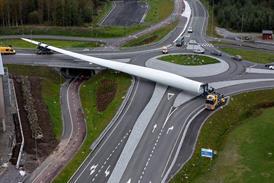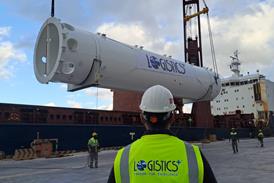February 7 - Safety measures built into its cranes and operating procedures proved their worth recently, says Liebherr.
Near the town of Wiesmoor, in Lower Saxony, Germany the surrounding peat bog proved unable to support the 415 tonne weight of a Liebherr LTR 11200 telescopic crawler crane involved in the recent installation of equipment at a wind farm and threatened to swallow up the machine.
After completion of its task, the crane was making its way to the next installation in the project when large cracks appeared at the edge of the crane's crawler track and the crane tipped over into a dangerously inclined position.
The crane rapidly extended its jack pads at the ends of the outspread star-shaped supports downwards, with the steel pressing into the sinking morass. Despite the boggy ground, the contact surface was large enough to stabilise the crane and bring it back into a horizontal position.
Thinking ahead, Burkhardt Hartinger , the man with the remote control who is the junior chief executive of the crane business of Burkhardt Hartinger had already spread the jack pads of the LTR 11200 before setting out on the move. "Of course, how could you do better in a situation like this", was his comment on the mishap, as he moved the supporting rams back upwards to allow his men to slide large timbers beneath the pads. The problem now was to stabilise the crane further, and then take off part of the equipment fittings so that it could travel the rest of the way.
A constant companion of Hartinger's LTR 11200 is a small version of the Liebherr telescopic crawler crane, an LTR 1100 . This mobile 100 tonne crane is used to set up the tower elements and the generator. These compact Liebherr crawler cranes, with a 52-metre telescopic boom, have been proving their worth on many wind farm and construction sites.
Burkhardt Hartinger and the LTR 11200 has completed the wind farm, having erected a total of six Enerconinstallations of the E-82 type, with a hub height of 108 m. The heaviest and most difficult part in each case was the blade star element, weighing in at 51 tonnes, which had to be fitted complete, and lifted with an outreach of some 18 metres.
















